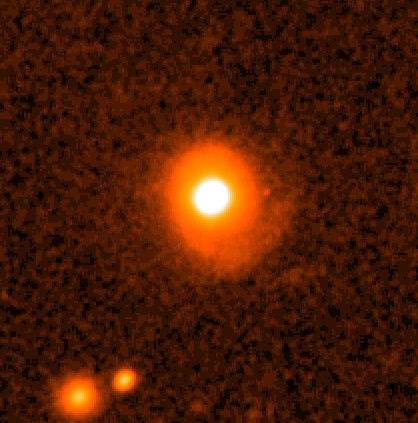Redshift of Quasars


Quasarstands for quasi-stellar radio source.Quasars are very distant objects, many of them billions of light-years away. They appear to exist in the central regions of galaxies, but they are enormously bright, radiating 100 times as much energy (or more) as typical galaxy.
Quasars were first noticed with the development of radio astronomy, i.e., with the advent of telescopes that look not at optical light, the kind our eyes detect, but instead at radio waves. The famous Third Cambridge Catalog of these radio sources, compiled by scientists in Britain, contained 471 objects. The object designated 3C 271 was the first one identified as a quasar.
Besides being tremendously bright, quasars are also very small -- so small, in fact, that many astronomers found the numbers almost impossible to believe. How could an object that was mabye only a few times the size of the solar system produce more energy than 50 galaxies? One theory is that a supermassive black hole lies at the center of these galaxies, powering the quasar. By "supermassive" I mean ten million or one hundred million times the mass of the Sun. The immense gravitational field of such an object would heat the surrounding matter in the galaxy so much that the energy production could approach that seen in a typical quasar.
Quasars are of great astrophysical importance because they take us back to a time when
the Universe was very young. Consider a quasar that is 8 billion light years away. We
don't see it as it is today. It took the light emitted by the quasar 8 billion years
to get here. So when we look at that quasar, we look at an era long ago, before the Sun
and Earth had even formed. Quasars are therefore a kind of window into the early Universe,
and allow us to investigate its history and, by extrapolation, its future.
(Original
text from Jefrey Hall).
The following Quasars have been selected as target objects for
our observing run:
| Name | R.A.(2000) | Decl. (2000) | Mag | Finding Chart | Hourly Airmass |
|---|---|---|---|---|---|
| Q2212-299 | 22h15m16.1s | -29d44m23s | 17.44 | FC | HA |
| Q2310-322 | 23h13m10.1s | -31d57m49s | 16.6 | FC | HA |
| Q2325-150 | 23h27m47.9s | -14d47m56s | 18.1 | FC | HA |
| Q0002-422 | 00h04m48.11s | -41d57m28.8s | 17.21 | FC | HA |
| PHL0957 | 01h03m11.3s | +13d16m16s | 16.57 | FC | HA |